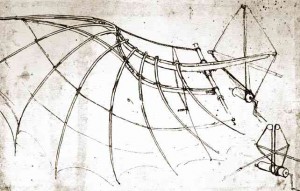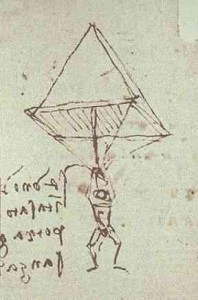Leonardo da Vinci was a great artist who lived during the Italian Renaissance. Today he is remembered mainly for his artistic contributions, such as the Mona Lisa. Da Vinci however, was much more than just an artist, he was also an incredible inventor and engineer. He had written up designs for everything from bridges, to tank, to helicopters. Originally Da Vinci wished to emulate birds and bats, so he designed a contraption that would allow its wearer to flap their wings in order to create thrust.

Da Vinci's design of a man-powered ornithopter.
It is not clear whether he built this device or if it was left as design. It is clear however that da Vinci realized it was too heavy to take off on its own. Modern day engineers have learned through trial and error that fully copying nature is not a good idea.
Robert Full mentioned when he spoke to our class how evolution has created animals that have many traits, and not all of them are specified towards a task. In fact sometimes animals can perform a task because a random set of evolutions occurred, and not because they needed some specific job to be completed. Rather than copying nature we should take aspects of nature, and try to make them work for us.
Da Vinci saw that a creature the size of a man could not take off the same way that a bird does, so he focused his efforts on the gliding aspect of birds. His next design was much lighter and much more practical. Da Vinci likely did not build this either, but a few modern day people tried to replicate his design. This is what happened:
As you can see Da Vinci’s design was successful! He didn’t have calculus or wind tunnels, but by observing the way birds glide he was able to replicate their coasting. There is some evidence that da Vinci flew, and if he did this was likely how he did it.
After realizing the success he could/did have with gliding da Vinci came up with one more “flying” invention. The parachute.
This would potentially allow him jump from a great height without being injured. The parachute builds up air resistance, and allows for a slowed descent. Like with most of his idea’s da Vinci likely observed something control its descent, and did his best to emulate it. The materials, including the fabric used, during da Vinci’s time lead scientist to believe that a parachute made during the Renaissance would be too heavy. Da Vinci’s parachute also did not have a hole in the top to stabilize it. Even so, a team of English inventors wanted to try it out.
Amazingly, Leonardo’s design was a success.
Da Vinci lived in a time when basic aeronautics were understood by few if any. Simply by using his observations and the blueprints that nature gave him, Da Vinci was able to design inventions that fly. Many of them were not built until hundreds of years later, and after hundreds of years we have come up with only slight variations to his designs. Powered flight was Da Vinci’s goal, and thanks to the internal combustion engine we have achieved it. Da Vinci saw that we are not birds, but he believed that we would one day fly.
Sources:
- Video of parachute at Teacher Tube
- Leonardo Da Vinci, web page by Carroll Gray
- Leonardo Da Vinci, web page at the AIAA History section.
- Leonardo Da Vinci: His Flying Machines, web page by “The Wanderling”
- The Da Vinci parachute.
- Leonardo Da Vinci Biography website: The parachute.


One Comment
Lorena Barba posted on November 19, 2011 at 5:21 pm
Hi Ted — some of your embedded images were being automatically re-directed to some placeholder, so I fixed it. I also cleaned up your source list a little bit.
For reference, here is EK131 student Will Livingston’s blog post on Da Vinci’s ornithopters:
http://blogs.bu.edu/biolocomotion/2011/10/03/early-flapping-flight-designs/
Like I commented there, there are estimates that in Leonardo’s surviving manuscripts, more than 500 sketches and 35 thousand words deal with flight.